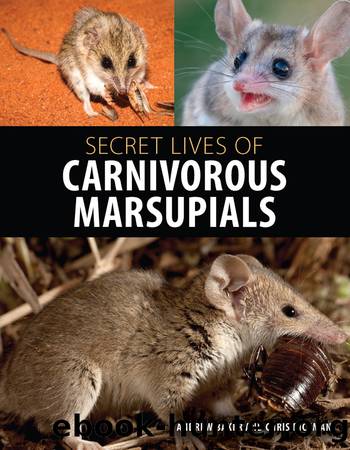Secret Lives of Carnivorous Marsupials by Andrew Baker;Chris Dickman;

Author:Andrew Baker;Chris Dickman;
Language: eng
Format: epub
ISBN: 9781486305162
Publisher: CSIRO Publishing
9
DIETS AND EATING HABITS
Early observers of carnivorous marsupials were often struck by their ferocity and the savage ease with which they made their kills. In 1866, for example, Gerard Krefft commented that the Yellow-footed Antechinus (Antechinus flavipes) would kill any number of mice if placed in a box with them. Thirty years later, Richard Lyddeker noted that âLike their allies, they [Fat-tailed Dunnarts, Sminthopsis crassicaudata] are inveterate enemies to Mice, which they fall upon at once with great ferocity, killing more than they can possibly devour.â Mice fare poorly in many accounts. New Guinean dasyures (Murexia spp.), mulgaras (Dasycercus spp.) and the Kowari (Dasyuroides byrnei) have been reported to dispatch mice with swift bites to the head and neck. Zoologist Oliver Pearson reported that captive Patagonian Opossums (Lestodelphys halli) killed mice at âlightning speed, eating everything â bones, teeth, and furâ. Larger carnivorous marsupials have long been reputed to tackle bigger prey. The Brush-tailed Phascogale (Phascogale tapoatafa), for example, was known not just as a killer of poultry, but â in the words of zoologist Frederick Wood Jones â to be a â⦠determined slayer of chickens, and one which killed not merely to appease its appetiteâ. The largest of the extant carnivorous marsupials, the Tasmanian Devil (Sarcophilus harrisii), had the worst reputation for ferocity. Writing in the mid-19th century, famed naturalist John Gould regarded the Devil to be âuntameable and savage in the extreme, [it] is not only destructive to the smaller kangaroos and other native quadrupeds, but assails the sheep-folds and hen-roosts whenever an opportunity occurs for its entering upon its destructive errand.â These and other accounts of carnivorous marsupials as vampires and blood-thirsty killers have given the group a fearsome reputation. But is this view justified? Here we examine the diets of carnivorous marsupials and describe the range of prey that they hunt. We review the strategies these carnivores use to detect their prey and the weapons they employ to subdue and process them. With carnivorous marsupials stalking landscapes throughout the Americas and Australasia, we finally consider the broader effects of these miniature killers on other species that share their habitats.
Download
This site does not store any files on its server. We only index and link to content provided by other sites. Please contact the content providers to delete copyright contents if any and email us, we'll remove relevant links or contents immediately.
| Amphibians | Animal Behavior & Communication |
| Animal Psychology | Ichthyology |
| Invertebrates | Mammals |
| Ornithology | Primatology |
| Reptiles |
Sapiens: A Brief History of Humankind by Yuval Noah Harari(14252)
The Tidewater Tales by John Barth(12608)
Mastermind: How to Think Like Sherlock Holmes by Maria Konnikova(7227)
Do No Harm Stories of Life, Death and Brain Surgery by Henry Marsh(6891)
The Thirst by Nesbo Jo(6828)
Why We Sleep: Unlocking the Power of Sleep and Dreams by Matthew Walker(6618)
Life 3.0: Being Human in the Age of Artificial Intelligence by Tegmark Max(5474)
Sapiens by Yuval Noah Harari(5294)
The Longevity Diet by Valter Longo(5021)
The Body: A Guide for Occupants by Bill Bryson(4974)
The Rules Do Not Apply by Ariel Levy(4861)
The Immortal Life of Henrietta Lacks by Rebecca Skloot(4525)
Animal Frequency by Melissa Alvarez(4395)
Why We Sleep by Matthew Walker(4360)
The Hacking of the American Mind by Robert H. Lustig(4318)
Yoga Anatomy by Kaminoff Leslie(4306)
All Creatures Great and Small by James Herriot(4233)
Double Down (Diary of a Wimpy Kid Book 11) by Jeff Kinney(4207)
Barron's AP Biology by Goldberg M.S. Deborah T(4099)
